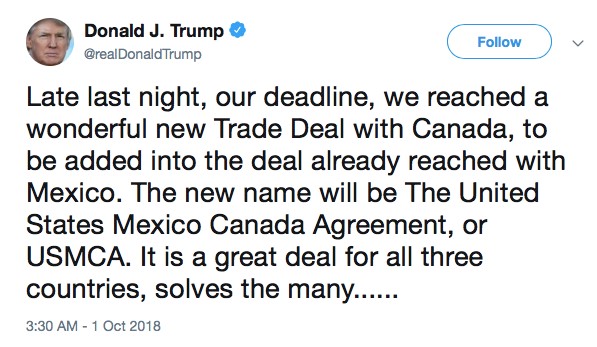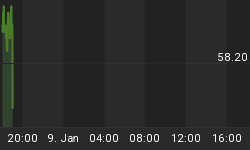After 14 months of wrangling and talk that Canada would be excluded from a new version of NAFTA, the drama is over, and a new era begins. NAFTA is dead, and its successor is a new acronym that no one will ever use, even if it will govern over $1 trillion in trade.
Over the weekend, the U.S., Canada and Mexico reached an agreement to replace NAFTA with the United States-Mexico-Canada Agreement (USMCA) in a deal that would give the U.S. greater access to the Canadian dairy market while at the same time allowed for extra imports of Canadian cars.
From Trump’s twitter perspective, the new trade agreement is a “wonderful” deal for all, with Canadian Prime Minister Justin Trudeau calling it a “good day for Canada”.

(Click to enlarge)
It all pulled together at the 11th hour; and if the talks had failed, Trump had threatened to exclude Canada, entirely.
"It will strengthen the middle class, and create good, well-paying jobs and new opportunities for the nearly half billion people who call North America home," US Trade Representative Robert Lighthizer and Canadian Foreign Affairs Minister Chrystia Freeland said in a joint statement.
For most, the 14 months of intense haggling brought U.S. relations with Canada to a low point that wasn’t worth it.
Emory University business professor Jeffrey Rosensweig told CNN that the U.S. “really hurt relationships” with a major ally “for the sake of a few gallons of milk”. Related: The Fed’s Latest Move Could Be The End Of The Bull Run
Indeed, it was an over-the-top amount of brinkmanship on the part of Trump when we consider how important Canada is as a trade partner. As Bloomberg points out, China is the U.S.’ biggest trading partner for only five states, while Canada is our largest export market for 36 states, buying $340.7 billion in goods and services from the U.S. last year.

(Click to enlarge)
So was milk worth it?
The new ‘NAFTA’ was in large part about milk. Trump wanted Canada to make a concession on dairy imports, and under the old deal the U.S. did not have access to Canada’s dairy market. And then last year, Canada created a special pricing system that put more protections on its dairy industry that ruffled U.S. feathers. At stake were a few big dairy companies in New York and Wisconsin—but not enough to risk trade relations with Canada.
Especially when you consider that despite Canada’s new protectionist milk measures, the U.S. still managed to export more dairy to the Canada than Canada did to the U.S.
One of the key points of the new deal will give U.S. farmers access to 3.5 percent of Canada’s dairy market, which is worth $16-billion annually.
Related: Mining Deals Are Dwindling
After the milk war, the auto industry was next on the list of grievances.
The deal gives Canada and Mexico a quota of 2.6 million cars allowed to be export to the U.S. as a form of protection of their auto industries if Trump imposes a 25-percent tariff on global car imports. Also, starting in 2020, in order to be tariff-free, all vehicles must have 75-percent of components manufactured in the new NAFTA area—up from 62.5 percent currently.
Further, 40 percent of the cars produced in the USMCA trade area must be manufactured in areas of North America that pay workers an average of $16 per hour. Finally, Canada won protection from U.S. anti-dumping tariffs for the lumber industry.
At the end of the day, the new auto rules could be a boost to North American workers; however, the deal could end up removing some small cars from the sales roster in North America because they would be rendered too expensive to produce. It could also reduce the number of cars made in North America for export overseas. In other words, the new deal could reduce competitiveness.
By Charles Benavidez for Safehaven.com
More Top Reads From Safehaven.com:
















